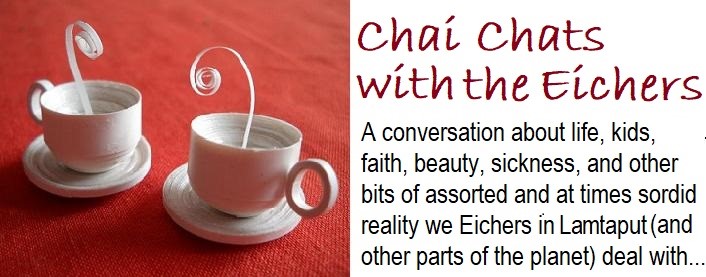Trees,
silent sentinelsof life on earth.- Ashrujit BhattacharjeeWalking in Landour brings much joy and lots of old friends.
The very oldest ones are the magnificent trees that grace this hillside. Here is a collection of some of the stalwarts.

The magnificent deodar (
Cedrus deodara) is found along the ridge and the north-facing slopes. These beauties are just below Elcott Lodge, where the path starts descending towards Fairy Glen and Jabbarkhet.

This is view of some venerable deodars are near the "Pepper Pot cave" - up from the ridge of the 'Seven Sisters'. One of the best ways of enjoying a tree is lying on the ground below it and resting from having hiked there (and having a picnic lunch in your belly).

Among the broadleaf trees - the handsome Indian Chestnut tree (
Aesculus indica also called Indian Horse Chestnut) forms an excellent counterfoil to the tall deodars. I particularly love the pale green that the chestnut adds to the solemn dark greens of the deodars and oaks.

The beautiful palmate leaves of the chestnut. They also have handsome spikes of flowers that emerge - giving the whole tree a beautiful decorative feel.

By far the most common tree in Landour is the sturdy Himalayan Oak (
Quercus leucotricophora). It blankets the south-facing slopes of Landour all the way down to Pari Tibba and below, and is found on the northern sides as well. This oak is commonly called 'banj oak' and forms the bulk of the Woodstock forests. We have a lovely stand on the acre of land that surrounds Shanti Kunj - with the picture above being some of them.
At lower elevations the banj oak fades into stands of Chir pine (
Pinus roxburghi). On some of the mountain spurs you can see the chir pines on the ridges (drier) with the banj oaks in the ravines (wetter).

The leaves of the banj are a dull green on top, but strikingly white beneath. When the wind blows through them whole trees can turn silver as the leaves skitter in the breeze. I personally like the golden setting sun best on the banj - it gives the mossy dark stems and the silvery leaves a wonderful aura.
Banj oaks are not just for decoration. They form a vital part of the forest human dynamics of the hills.

This banj oak has been 'lopped' by village women for fodder. The leaves are a major source of food for their cattle. It doesn't look very pretty - but given the right amount of lopping - this 'pole shaped' tree actually is quite efficient in producing leaves - for cattle of course...
A big part of my studies in forestry got a push from a year I spent with my parents in 1989-90 when I volunteered with a local development group which was studying this issue. It was one of the first times that I saw science being used in a rural setting and was a good push towards the social forestry focus I took. A good friend of mine from the Yale School of Forestry and Environmental Studies is the amazing Rajesh Thadani. Rajesh went on to get a doctorate in Forestry and is an expert in oak regeneration (see
this article for example).

Mussoorie does not have a lot of wild life (other than perhaps the inevitable Woodstock student - but that is a different genre altogether). We do have the occasional langur. These ghostly grey monkeys are a beauty to see - especially when they swing from oak to oak - or sit pensively on the branch of a deodar.

Mussoorie has a beautiful red flowering tree - the Rhododendron (
Rhododendron arboretum). The flowers usually come out in winter - so we did not see many during our visit this summer - other than the odd final bloom hanging on in trees tucked in cold spots on the north-facing slopes of Landour.

A favourite tree for me is the maple (
Acer spp. probably caesium). The placed where I see it are towards bottom of the path past Fairy Glen - and also in the Oakville Estate (which is where the above picture was taken).

Most of the Himalayan cypresses (
Cupressus torulosa) we see are relatively small since they are a favourite species for the forest department to plant. There are, however, a few giants on the path that goes down past Fairy Glen.
Finally a short look at the Himalayan fir:

These firs are normally only found in very cold parts of the hill. These beautiful Himalayan fir (
Abies pindrow) were found in all age groups - from large giants down to small seedlings near Fairy Glen.
Our short look at some of the trees of Landour is over. It should be noted that almost all of these pictures were taken in land owned by Woodstock School. The school properties are a rich treasure of biodiversity - and a blessing to the hillside.
I remember reading a volume of
Dietrich Brandis' (the founder of the Indian Forest Service) Trees of India in the Woodstock School library. It is a great blessing that their trees are not just illustrations in a musty old book from colonial days - but living, breathing, beauty givers that are enjoyed across generations.
 I saw the old woman crying. I thought she was crying for herself.
I saw the old woman crying. I thought she was crying for herself.













































